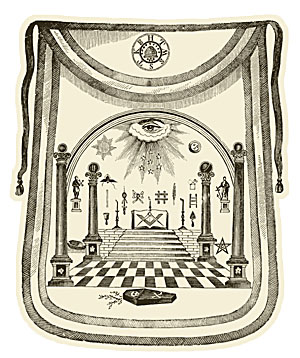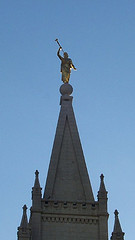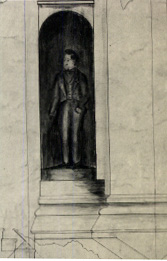|
Temple
Endowment Ceremony Clothing Symbolism
Men’s
Hat
The baker-looking hat symbolizes the crown of light where
the Godhead rests directing the rest of the body (church).
Men’s
Hat Ribbon
The ribbon on the hat has three portions, symbolizing the
Godhead (Father, Son, and Holy Ghost).
Attachment
of Ribbon to Robe
The ribbon (the Godhead) is attached to the Priesthood (the
robes of the Priesthood) through the little string which
symbolizes revelation.
Shoulder
Loops
Notice that there are four loopty-loops on the shoulder
portion of the robes, broken up into three different sections
making a total of twelve sections. These 12 sections symbolize
the quorum of the twelve apostles.
Top
Loops
Note that the top three loops of the priesthood robe, for
men, is attached via the string (revelation) to the hat
(the godhead). These top 3 loops represent the First Presidency,
which is connected by revelation to the Godhead.
Sash
The sash is the bond of charity as Paul said.
Green
Apron
The apron worn by temple patrons is green, which is symbolic
of life. The fig leaves on the green apron are a fruit known
for the countless multitude of seeds. This green apron full
of fruitful seeds is worn after Adam and Eve are cast out,
and strategically over the loins symbolizing the new power
to procreate, be fruitful and multiply.
Satan's
Apron
 Currently
in temple ceremonies, Satan wears a dark apron, which he
says is a symbol of his powers and priesthoods. But before
the 1960’s, Satan in the temple wore an apron with
many symbols on it, including an all-seeing eye, beehive,
skull and crossbones, compasses, suns, moons, stars, etc..
If you don't believe it, ask your grandparents who participated
in live sessions before 1960. Currently
in temple ceremonies, Satan wears a dark apron, which he
says is a symbol of his powers and priesthoods. But before
the 1960’s, Satan in the temple wore an apron with
many symbols on it, including an all-seeing eye, beehive,
skull and crossbones, compasses, suns, moons, stars, etc..
If you don't believe it, ask your grandparents who participated
in live sessions before 1960.
Interestingly,
George Washington, a Mason, wore an identical apron to the
one Satan wore in the temple. (Click
the apron on the right to discover the meanings of the symbols.)
Shield
Used During Initiatory
The shield during the initiatory is a symbol of the atonement.
It is said to be the same as the one Christ used to cover
the naked man that Christ initiated the night of His atonement
in the Garden of Gethsemane (See Mark 14:51-52).
Garments
The symbols
on the garment are explained in the temple endowment. However,
garments has gone through several revisions since they were
first introduced in Nauvoo. Read the interesting history
of garments here.
Outside
Temple Symbolism
 Angel
Moroni Statue Angel
Moroni Statue
Moroni on top the temple is there to announce that the fullness
of the everlasting gospel has been restored to earth.
Spires
on Salt Lake Temple
Six Spires, three on each end of the temple, represent the
restoration of the priesthood. The three east spires, representing
the Melchizedek Priesthood, are six feet higher than the
three west spires, representing the Aaronic Priesthood.
Also the three east spires represent the First Presidency,
and the three west spires the Presiding Bishopric.
Stars
outside Temple
Star Stones are found all over the temple, like on keystones
above corner tower windows and above the lower set of windows
on the walls. They are reminders of the pillars of heaven
and the glory of God, and of the telestial kingdom. The
stars pointing downward represent the reception of truth
from the heavens, and also the priesthood, that the "lost
may find themselves," according to Truman O. Angell,
temple architect.
Moon
Stones on Salt Lake Temple
All 50 moon stones are on the buttresses in line with the
top of the first row of oval windows. They illustrate the
computation of the earth’s time, and also the terrestrial
kingdom.
Earth
Stones
The scriptures refer to the earth as the "Footstool
of God" (see Isaiah 66:1, Matthew 5:35; 1 Nephi 17:39).
A footstool is where a king sets his feet while on his throne.
Sun
Stones on Salt Lake Temple
The sun stones also number 50 and are in line with the top
of the upper row of oval windows. They also represent the
computation of the earth’s time, and in addition,
stand for the celestial kingdom.
Saturn
Stones on Salt Lake Temple
The Saturn stones are located directly below the parapet
on each side of the six towers. They represent Kolob, the
dwelling place of God.
Big
Dipper
The Big Dipper is an easily overlooked feature of the west
center tower of the Salt Lake Temple. Small stars forming
the shape of the Big Dipper can be seen high on the tower,
above two Sun Stones, and the All-Seeing Eye Stone.
The Big Dipper
has historically been a way of orient one's self when lost.
Its presence represents the lessons taught in the temple
and the eternal direction they give to life. Further, the
symbol of the big dipper on the temple is oriented to find
the actual North Star when standing in front of the temple.
Follow an imaginary line formed by the last two stars of
the cup of the dipper. This leads one to the actual North
Star inthe sky.
Corner
Tower Windows on Salt Lake Temple
The five windows on the east end of the building commemorate
the five offices of the Melchizedek priesthood: Elder, Seventy,
High Priest, Patriarch, and Apostle. The four on the west
end of the building stand for the four offices of the Aaronic
priesthood: Deacon, Teacher, Priest, and Bishop.
All-Seeing
Eye
The all-seeing eye is a symbol of omniscience, omnipresence,
and the omnipotent nature of God, is found on the east facade
of the central tower, just below the dedicatory inscription.
Hand
Clasp
The Hand
Clasp is located directly below the Alpha and Omega Scroll
on both east and west central towers. Mentioned in Galatians
2:9, these are the "Right Hands of Fellowship."
Jeremiah 31:32 compares the hand clasp to entering into
a covenant with God. Those familiar with the Endowment Ceremony
will likely see the similarity between this symbol and the
ritual; it is also similar to Masonic symbols.
Inverted
Pentagram
Upside down stars are found on the keystones of the arched
windows and doorways of the main body of the temple. Similar
stars were on the Nauvoo Temple and called Morning Stars
(see Doctrine and Covenants 128:23). It was used in Nordic
countries, where it was drawn on doors and walls as protection
against trolls and evil.
Statues
Two statues used to appear on the east side of the temple
in specially designed niches next to the giant doors. The
statues were of Joseph Smith and Hyrum Smith. They have
been removed.

|